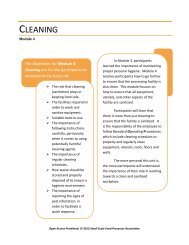Here - Small Scale Food Processor Association
Here - Small Scale Food Processor Association
Here - Small Scale Food Processor Association
Create successful ePaper yourself
Turn your PDF publications into a flip-book with our unique Google optimized e-Paper software.
The European Union –<br />
By Pernille Fischer Boulter, President & CEO of Kisserup International Trade Roots<br />
Obvious Opportunities<br />
Imagine if each one of the fifty U.S. states spoke a different<br />
language. Imagine if the cultural differences between each of the states<br />
was more distinctive than, say, New Orleans and Alaska. Outrageous<br />
inter-state transportation costs, no existing Free-Trade agreement with<br />
Canada and an incredibly successful domestic manufacturing base.<br />
Well, that pretty much sums up the European Union (EU). Discouraged<br />
yet?<br />
This is pretty much the end of the bad news. The EU consists of 495<br />
million consumers living in 27 countries! The collective buying power<br />
of the various member countries is larger than the U.S. One just has<br />
to understand the EU in order to begin to exploit it. Today, there is<br />
one common currency (in most EU countries). And likely in the near<br />
future, there will be a Canada European Comprehensive Economic and<br />
Trade Agreement (CETA).<br />
One of the challenges in understanding the EU is that you are not<br />
“just” selling to the EU, you are often selling to one, several or all of<br />
their member states. For example, lobsters<br />
exported to the Netherlands will usually<br />
be re-exported to five other EU<br />
countries.<br />
When we talk about food within<br />
the EU, where English is usually not<br />
the first language, let us first define<br />
the two most popular food terms:<br />
• <strong>Food</strong> security: <strong>Food</strong><br />
security is defined by the<br />
World Health Organization<br />
as<br />
access to<br />
sufficient,<br />
safe and nutritious food.<br />
• <strong>Food</strong> safety: <strong>Food</strong> safety focuses on setting standards regarding<br />
the safety of food, good manufacturing practices and quality<br />
control of agricultural products at all steps of the processing<br />
chain.<br />
<strong>Food</strong> safety, for many Europeans, is closely tied to green food,<br />
organic food and environmental impacts. This leads to another new<br />
term: green procurement. A trend in the EU, green procurement impacts<br />
decision makers in many ways:<br />
• The fertility and biological activity of the soil is maintained or<br />
increased by the use of pesticides and fertilizers, resulting in<br />
water and soil contamination (eutrophication, acidification and<br />
ecotoxity). Organic agriculture has less negative impact.<br />
• Soil erosion.<br />
• Loss of biodiversity.<br />
• There is uncertainty about the use of genetically modified organisms<br />
(GMO) and their impact on the environment and human<br />
health.<br />
• Use of energy for processing food and transportation.<br />
• Use of resources for packaging.<br />
It is also very common to see specialty food products sold in EU<br />
states containing 10 or more languages on the primary packaging.<br />
The new EU Organic Logo<br />
The EU organic farming logo offers consumers’ confidence about<br />
the origins and qualities of their food and drink and its presence on<br />
any product ensures compliance with the EU organic farming regulation.<br />
As of July 2010, the EU organic logo is obligatory for all organic<br />
pre-packaged food products within the EU (see it at http://ec.europa.<br />
eu/agriculture/organic/eu-policy/logo_en).<br />
It is also possible to use the logo on a voluntary basis for non<br />
pre-packaged organic goods produced within the EU or any organic<br />
products imported from third countries.<br />
Do your research and understand both the overall EU requirements<br />
and the regional differences. Dag Falck of SSFPA is among those<br />
who have been and continue to provide very valuable insight for food<br />
processors. A recent look at www.ota.com will provide further understanding<br />
and support, and Agriculture and Agri-foods Canada (www.<br />
agr.gc.ca) provides information on international market supports and<br />
programs.<br />
So go ahead—there are obvious opportunities in the EU—supported<br />
by Canada! ■<br />
Pernille Fischer has worked in over 50 countries worldwide, she<br />
speaks six languages and she is on PROFIT’s Magazine’s panel of<br />
Export Experts. Kisserup has offices in Halifax, Nova Scotia and<br />
Copenhagen, Denmark.<br />
16 We’re BIG on SMALL!















